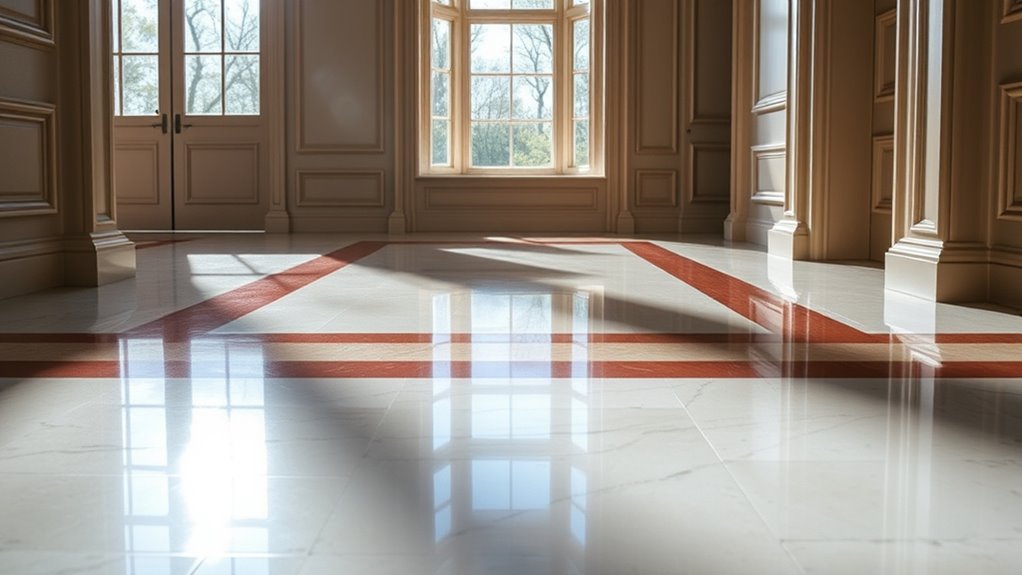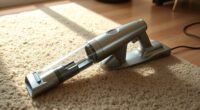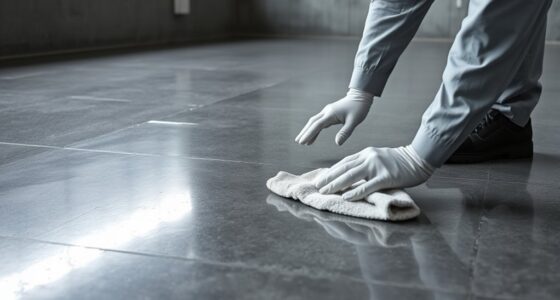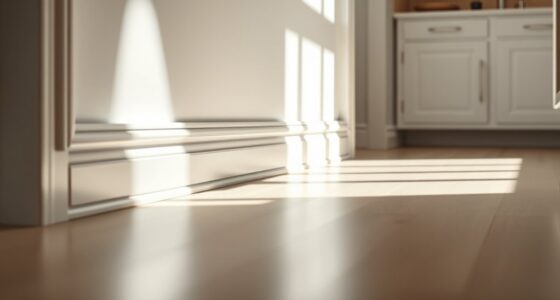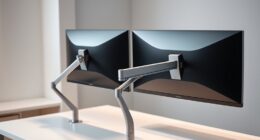To create thresholds on your salon floors that actually work, focus on safety, accessibility, and style. Use low, smoothly beveled edges to prevent tripping and make passages seamless. Secure them firmly and check regularly for damage or loose parts. Proper placement at doorways and where different flooring types meet is key. Well-designed thresholds enhance space flow and safety, all while maintaining a professional look. Keep these tips in mind to improve your salon’s passages as you explore further.
Key Takeaways
- Use low, beveled thresholds to ensure smooth transitions and prevent trips.
- Install thresholds securely flush with flooring to avoid hazards.
- Place thresholds at doorways and between different flooring types for safety and accessibility.
- Select durable, matching materials like wood or metal for aesthetic consistency.
- Regularly inspect and maintain thresholds to ensure safety and longevity.
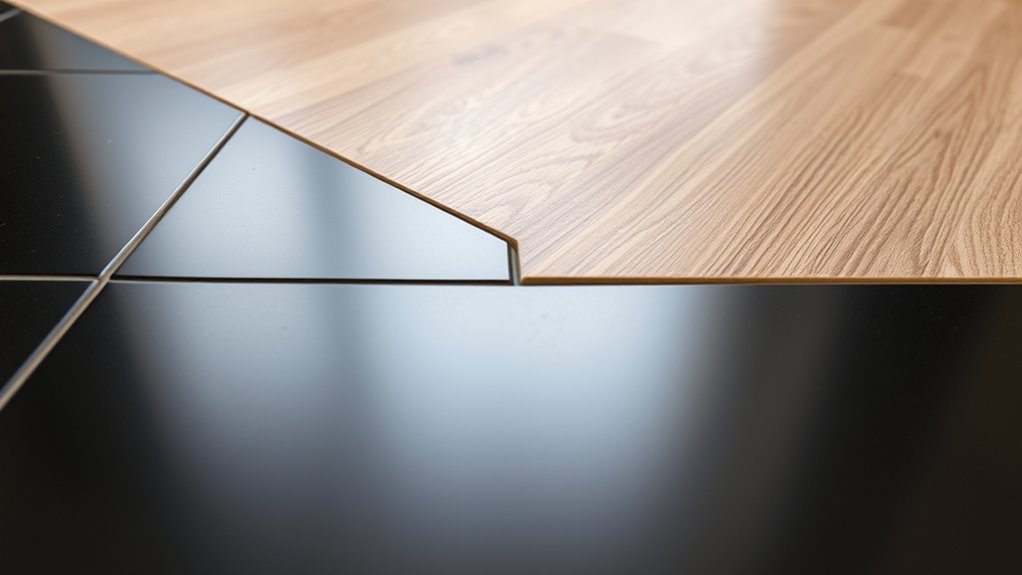
Thresholds on salon floors serve a pivotal role in guaranteeing safety, accessibility, and aesthetic appeal. When you’re working in a busy salon, you might not always notice these small yet essential features, but they can make a significant difference in how smoothly your space functions. Properly designed thresholds help prevent trips and falls, especially when clients or staff are moving between different areas or floors. They act as a physical reminder to slow down and pay attention, reducing the risk of accidents that could lead to injuries or liability issues. Additionally, thresholds contribute to a more organized and professional appearance, signaling that safety and comfort are priorities in your salon.
Properly designed thresholds enhance safety, accessibility, and a professional look in your busy salon.
One of the key benefits of well-designed thresholds is their ability to accommodate diverse needs. For example, if you’re catering to clients with mobility challenges or using wheelchairs, thresholds that are too high or poorly installed can create barriers. When you install thresholds that are low and smoothly beveled, you guarantee that everyone can move around your salon comfortably. This not only enhances accessibility but also demonstrates your commitment to inclusivity. Furthermore, adjustable or flexible thresholds can be helpful in spaces where you might need to change layouts or flooring types over time. Using materials that blend seamlessly with your flooring creates a cohesive look, while still providing the necessary functionality.
Another aspect to consider is how thresholds influence the overall aesthetic of your salon. You want them to be unobtrusive yet effective. When you select thresholds made from materials that complement your flooring—such as wood, metal, or rubber—you maintain a sleek, professional appearance. In some cases, you might choose decorative thresholds that add a touch of style without compromising safety. The key is balancing form and function; a well-chosen threshold should not detract from your interior design but instead enhance it subtly. Ensuring proper installation and maintenance is also crucial, as installation quality directly impacts safety and longevity.
Installing thresholds properly is essential. If you neglect this step, they can become hazards rather than safety features. Make sure they are securely anchored and flush with the floor surface. This prevents tripping hazards and ensures durability. Regular maintenance, such as checking for loose edges or worn-out materials, keeps your thresholds in top condition and continues to serve their purpose effectively. As you review your salon layout, consider how thresholds are positioned—strategically placed at doorways, between different flooring types, and in areas where water or moisture might be an issue. Proper placement maximizes their safety benefits and improves overall flow within your space.
Frequently Asked Questions
What Are the Most Durable Materials for Salon Floor Thresholds?
You should choose materials like stainless steel, aluminum, or hardwood for salon floor thresholds. These options are highly durable, resistant to wear, and easy to clean, making them ideal for high-traffic areas. Stainless steel and aluminum offer excellent corrosion resistance, while hardwood provides a sleek, natural look. By selecting these materials, you guarantee your thresholds withstand daily use and maintain their appearance over time.
How Do Thresholds Impact Wheelchair Accessibility in Salons?
Thresholds greatly impact wheelchair accessibility in salons by either facilitating smooth movement or creating obstacles. When you choose low-profile, beveled thresholds, you make it easier for wheelchairs to cross without difficulty. Avoid high, abrupt thresholds that can cause tripping or get stuck. Properly designed thresholds ensure clients with mobility challenges can navigate your salon comfortably, promoting inclusivity and compliance with accessibility standards.
Are There Eco-Friendly Options for Salon Floor Crossings?
Eco-friendly options for salon floor crossings combine sustainability with accessibility. You can choose recycled rubber or cork, which are durable and gentle on the environment. These materials provide smooth, slip-resistant surfaces that facilitate wheelchair movement while reducing ecological impact. By selecting eco-conscious thresholds, you support sustainability and guarantee your salon remains inclusive and accessible. It’s a thoughtful choice that balances environmental responsibility with practical needs, creating a welcoming space for everyone.
What Is the Typical Installation Cost for Custom Thresholds?
The typical installation cost for custom thresholds ranges from $200 to $600, depending on materials, design complexity, and size. You’ll want to take into account factors like customization, labor, and any additional features you desire. It’s best to get quotes from local contractors to guarantee accurate pricing. Keep in mind that investing in quality materials can save you money long-term by reducing wear and the need for replacements.
How Often Should Salon Thresholds Be Inspected or Replaced?
You should inspect your salon thresholds at least every six months to guarantee they’re in good condition. Replace them if you notice significant wear, cracks, or if they no longer provide a smooth passage. Regular checks help prevent accidents and maintain a professional appearance. If thresholds become damaged or loose, address the issue promptly to avoid safety hazards and ensure continuous, safe access for clients and staff.
Conclusion
By implementing effective thresholds on salon floors, you create smooth passages that enhance safety and flow. Did you know that properly designed thresholds can reduce trip hazards by up to 40%? Incorporating thoughtfully chosen crossings not only improves accessibility but also shows your commitment to client well-being. So, next time you consider floor design, remember that well-placed thresholds aren’t just functional—they’re essential for a safer, more welcoming salon environment.
